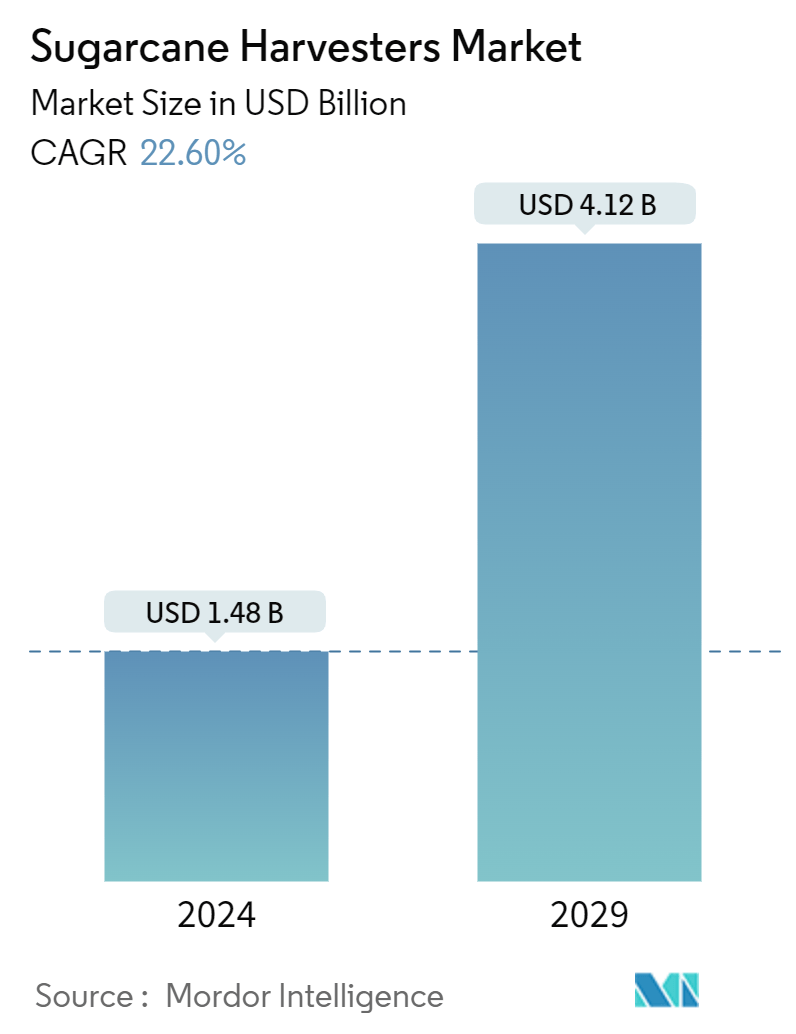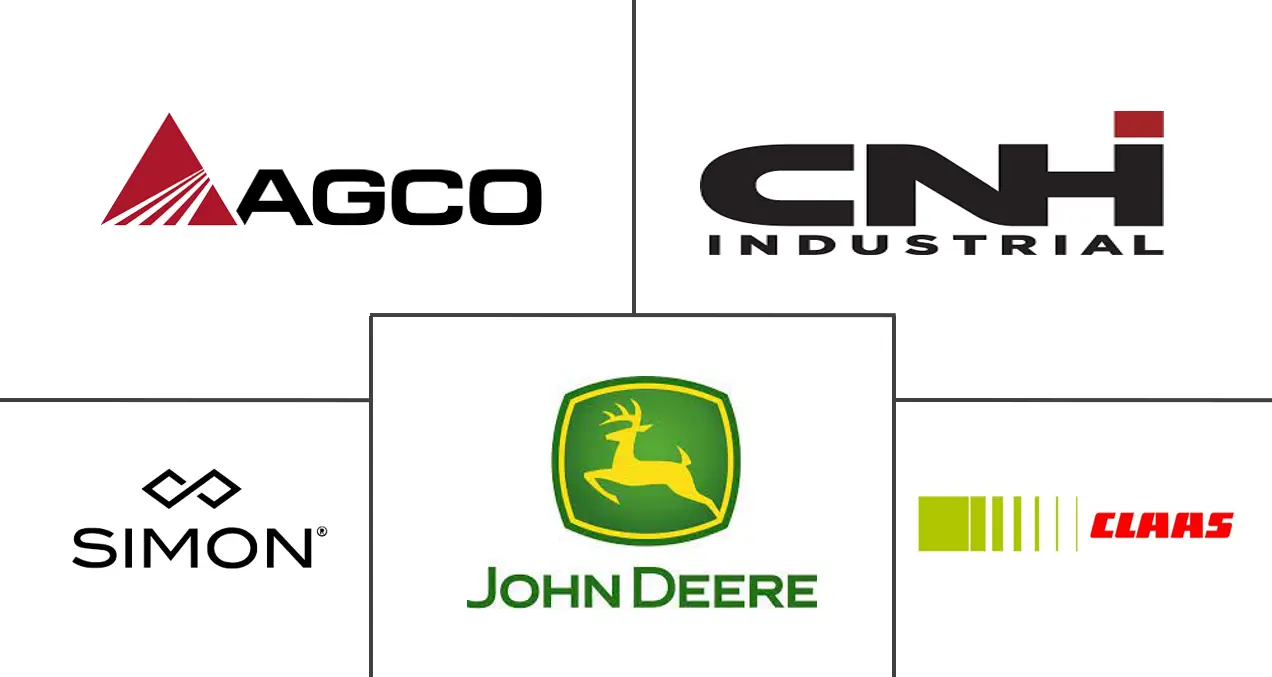Market Size of Sugarcane Harvesters Industry

| Study Period | 2019 - 2029 |
| Market Size (2024) | USD 1.48 Billion |
| Market Size (2029) | USD 4.12 Billion |
| CAGR (2024 - 2029) | 22.60 % |
| Fastest Growing Market | Asia Pacific |
| Largest Market | North America |
| Market Concentration | Medium |
Major Players
*Disclaimer: Major Players sorted in no particular order |
Sugarcane Harvesters Market Analysis
The Sugarcane Harvesters Market size is estimated at USD 1.48 billion in 2024, and is expected to reach USD 4.12 billion by 2029, at a CAGR of 22.60% during the forecast period (2024-2029).
Sugarcane, a significant industrial crop, is cultivated in over 90 countries worldwide. Brazil, India, China, Pakistan, and Thailand are the top sugarcane producers globally. According to the Food and Agriculture Organization (FAO), Brazil produced more than 724.4 million metric tons of sugarcane in 2023, followed by India with over 439.4 million metric tons and China with 103.9 million metric tons. The global sugarcane harvester market has steadily evolved over the past decade, transforming sugarcane production worldwide. These specialized machines have become increasingly important in addressing labor shortages, meeting productivity demands, and addressing sustainability concerns in the sugarcane industry.
Brazil, the world's largest sugarcane producer, has been at the forefront of adopting and driving innovations in sugarcane harvesting technology. Over 95% of the sugarcane harvest in regions like Sao Paulo is mechanized, significantly increasing productivity. The demand for sugarcane harvesters in Brazil has been strong, with major manufacturers such as Case IH and John Deere maintaining a significant presence with various models.
Technological advancements have been a key feature of the global sugarcane harvester market. Modern harvesters now commonly include GPS guidance systems, yield monitoring technologies, and precision cutting mechanisms. For instance, In 2023, CNH Industrial introduced its new Austoft 9000 series, featuring AI-powered optimization systems that adjust harvesting parameters in real-time based on crop and field conditions.
Sugarcane Harvesters Industry Segmentation
A sugarcane harvester is a large piece of agricultural machinery used to harvest and partially process sugarcane by cutting the stalks at the base, stripping leaves, and removing dust and dirt particles. The sugarcane harvesters market is segmented by type into whole stalk harvesters and chopper harvesters and geography into North America, Europe, Asia-Pacific, South America, and Africa. The report offers the market size and forecasts for volume (units) and value (USD) for all the above segments.
| Type | |
| Whole Stalk Harvesters | |
| Chopper Harvesters |
| Geography | ||||||||
| ||||||||
| ||||||||
| ||||||||
| ||||||||
|
Sugarcane Harvesters Market Size Summary
The sugarcane harvester market is poised for significant growth, driven by the increasing mechanization of agriculture and supportive government policies. The adoption of machinery in sugarcane harvesting is gaining momentum, particularly in regions like Asia-Pacific, where countries such as India and China are experiencing a decline in agricultural labor due to urban migration. This labor shortage has led to a heightened demand for agricultural machinery, including sugarcane harvesters, as farmers seek to maintain productivity and efficiency. The market is further bolstered by the rising domestic consumption of sugar and the need to enhance production and productivity through modern agricultural techniques. Key players in the market are expanding their presence through strategic partnerships and innovations, aiming to meet the growing demand for advanced harvesting solutions.
The market landscape is moderately consolidated, with prominent companies like Deere & Company, CNH Industrial NV, AGCO Corporation, Simon Group, and Claas KGaA mBH leading the charge. These companies are focusing on new product launches and technological advancements to enhance harvesting capabilities and reduce operational costs. Government support, in the form of subsidies and incentives, is playing a crucial role in encouraging the adoption of sugarcane harvesters, particularly in countries with significant sugarcane production such as Brazil, India, and Thailand. The anticipated improvements in weather conditions and stable sugarcane prices are expected to further drive market growth, making sugarcane harvesters an essential investment for farmers looking to optimize their operations.
Sugarcane Harvesters Market Size - Table of Contents
-
1. MARKET DYNAMICS
-
1.1 Market Overview
-
1.2 Market Drivers
-
1.2.1 Decline in Farm Labor Availability
-
1.2.2 Increasing Mechanization in Agriculture
-
1.2.3 Rising Demand for Efficient Harvesting Technologies
-
-
1.3 Market Restraints
-
1.3.1 High Initial Cost of Harvesters
-
1.3.2 Limited Access to Advanced Machinery in Developing Regions
-
-
1.4 Porter's Five Forces Analysis
-
1.4.1 Bargaining Power of Suppliers
-
1.4.2 Bargaining Power of Buyers
-
1.4.3 Threat of New Entrants
-
1.4.4 Threat of Substitutes
-
1.4.5 Intensity of Competitive Rivalry
-
-
-
2. MARKET SEGMENTATION
-
2.1 Type
-
2.1.1 Whole Stalk Harvesters
-
2.1.2 Chopper Harvesters
-
-
2.2 Geography
-
2.2.1 North America
-
2.2.1.1 United States
-
2.2.1.2 Canada
-
2.2.1.3 Mexico
-
2.2.1.4 Rest of North America
-
-
2.2.2 Europe
-
2.2.2.1 France
-
2.2.2.2 Portugal
-
2.2.2.3 Spain
-
2.2.2.4 Rest of Europe
-
-
2.2.3 Asia-Pacific
-
2.2.3.1 India
-
2.2.3.2 China
-
2.2.3.3 Thailand
-
2.2.3.4 Japan
-
2.2.3.5 Australia
-
2.2.3.6 Rest of Asia-Pacific
-
-
2.2.4 South America
-
2.2.4.1 Brazil
-
2.2.4.2 Argentina
-
2.2.4.3 Rest of south America
-
-
2.2.5 Africa
-
2.2.5.1 South Africa
-
2.2.5.2 Rest of Africa
-
-
-
Sugarcane Harvesters Market Size FAQs
How big is the Sugarcane Harvesters Market?
The Sugarcane Harvesters Market size is expected to reach USD 1.48 billion in 2024 and grow at a CAGR of 22.60% to reach USD 4.12 billion by 2029.
What is the current Sugarcane Harvesters Market size?
In 2024, the Sugarcane Harvesters Market size is expected to reach USD 1.48 billion.

